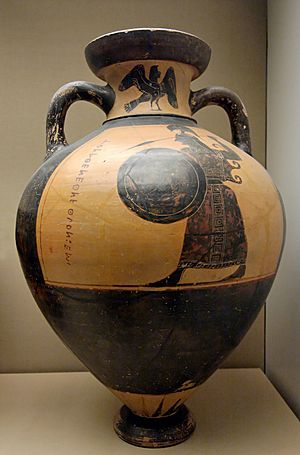Burgon vase facts for kids
The Burgon vase is a very old and important Panathenaic amphora. It was made around 560 BC. This special vase is named after the ancient Greek artist known as the Burgon Group. Today, you can see it at the British Museum in London.
This vase is about 61 centimeters (24 inches) tall. It has a unique shape: it's short and wide, with a small opening at the top and a short neck. The handles are small and close to the body, and its base is tiny compared to the rest of the vase. The amphora was found in 1813 in Athens, Greece. It is named after Thomas Burgon, a merchant who brought it to England. When it was found, the vase was full of bone fragments, meaning it was used as a burial urn. Sadly, one side of the vase was damaged during its discovery.
Contents
What Does the Burgon Vase Show?
The Burgon vase is painted in the black-figure style. This means the figures are black against the reddish clay. The vase shows images of the Greek goddess Athena, a flying siren, an owl, and a two-horse chariot.
Athena: Goddess of Wisdom
On one side of the vase, the goddess Athena is shown facing left. She wears a helmet with a low crest, which looks a bit like a cap. Her left arm holds a spear with a very detailed tip. Athena's clothing is a long, sleeveless dress called a peplos. It is belted at her waist.
The top part of her peplos, called a diploidion, is folded over her shoulders and decorated with a meander pattern. This pattern looks like a winding line. The skirt of her dress has a vertical band of solid squares and a decorated hem. Athena stands firmly with her feet apart. The border of her aegis (a special shield or cloak) is shown with two large, twisting snakes. Another snake peeks over her shoulder. The shield she holds in her right arm has a dolphin facing left.
Ancient Greek Writing
To the left of Athena, there is an inscription. It is written from right to left, which was common in ancient times. The words say: ΤΟΝΑΘΕΝΕΘ(Ε)ΝΑΘΛΟΝΕΜΙ. This means, "I am (one) of the prizes from Athens." This tells us the vase was a prize given out at a special event in Athens.
The Chariot Race Scene
On the back of the vase, there is a young, beardless charioteer sitting down. He wears red clothing and drives a two-horse chariot to the right. His feet are on a running board. He holds the reins in his right hand and a kalaurops in his left. A kalaurops was a staff with bells, used to encourage the horses. The chariot wheels are unusual, with only two spokes and two extra supports. They look similar to an ancient bronze wheel found in Olympia.
Siren and Owl
On the plain neck of the vase, there are two more figures. On the front, there is a siren. On the back, there is an owl. Both the siren and the owl have their wings held in the exact same position.
See also
 In Spanish: Vaso Burgon para niños
In Spanish: Vaso Burgon para niños


